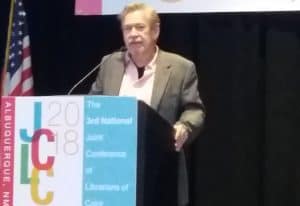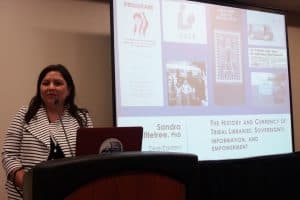
Across the country, universities like Brown, Princeton, and University of North Carolina at Chapel Hill are evaluating and renaming buildings and monuments that honor historical figures with ties to the Confederacy, Ku Klux Klan, and slavery.
“Building and place names do matter. They can be those institutional symbols of racism,” said Natalia Fernández, associate professor at Oregon State University (OSU) and curator and archivist of the Oregon Multicultural Archives and OSU Queer Archives in Corvallis. “It can be very impactful, hurtful, and it’s important that we have these conversations.”
In “Campus Connections to White Supremacy: Reconciliation through Community Engagement and Historical Research,” a September 27 session at the third National Joint Conference of Librarians of Color in Albuquerque, New Mexico, Fernández shared with attendees OSU’s own process of evaluating five campus buildings named after four people—and the factors that went into the decision to rename three of the buildings.
“What does it mean for OSU to value equity and inclusion if individuals after whom its buildings are named did not?” Fernández asked.
The buildings OSU decided to evaluate were named for Benjamin Lee Arnold (a former OSU president and Confederate officer), Joseph C. Avery (who ran a proslavery newspaper), Thomas Hart Benton (who had well-documented white supremacist views), and Amory T. “Slats” Gill (a former OSU basketball coach whose team became desegregated after he retired).
“Oregon is known as being liberal but it has a lot of issues the state is still working through,” said Fernández. “It’s a predominately white institution in predominantly white state with a racist past.”
As more students of color began attending OSU in 1960s, the school saw individuals and groups protesting injustices and a lack of university support. In 2015, the formation of Students of Color Speak Out led to the establishment of an Office of Institutional Diversity, which Fernández says was an instrumental participant in the evaluation and renaming process.
Fernández also believes archivists, curators, and special collections librarians have a key role to play in this undertaking.
“We requested to be a part of this process from the very beginning,” she said. “We know the archives was going to be called upon. We thought, let’s get ahead of the game, start doing research even before it’s asked of us.”
With OSU, that process—which was completed in just one academic quarter—consisted of the formation of Building and Place Names Committee, development of evaluation criteria, responses to student protest, a communications plan, historical research for a team of scholars, and a community engagement plan, before the ultimate decision.
Fernández said that librarians’ experiences facilitating conversations, bringing the community together, and connecting researchers to materials that they need are skills integral to a building name evaluation process. These skills paired seamlessly with the research and community engagement components at OSU, and Fernández saw herself acting as a liaison between different stakeholder groups.
The library also took a role in educating the community. “We had some misinformation. We wanted to make sure we provided the correct information and provided the documentation,” said Fernández, whose team created a LibGuide for the public.
Still, the library did not conduct its own research. “As archivists, [the university] asked us to do historical research. We had to say ‘we’re not really capable of that, get your own researchers,’” said Fernández, who recommends setting firm boundaries with regard to involvement.
Instead, the library took a greater role in managing facilitated conversations and workshops, to make sure the community was being heard in the process.
“We made public the historical reports at least three days before the sessions,” said Fernández. “We asked what reconciliation meant to them, asked how it would feel to walk into a place named for someone against your values. We were really trying to engage them in ‘how does this match up to the criteria we developed?’ and using evidence.”
Ultimately, it was decided that Benton Hall, Benton Annex, and Avery Lodge should be renamed. OSU President Edward John Ray set criteria for new names, and a second set of community engagement meetings approved the new names: Avery Lodge is now Champinefu Lodge—champinefu meaning “at the place of the blue elderberry” and used with permission from local Kalapuya tribal members; Benton Hall is now Community Hall; and Benton Annex is now the Hattie Redmond Women and Gender Center, named for an African American and Oregonian who fought for women’s suffrage.
OSU sees their undertaking as successful, and now plans to review all of the building names.
Though Fernández admitted she would have liked to have seen all five of the evaluated buildings renamed, she said the community respected the thoughtfulness and transparency that went into the renamings.
“The reason we didn’t get a lot of pushback on the decisions was because people appreciated the process,” she said.


